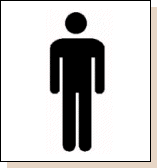|
The above song, a one-hit wonder from 1971, is a particularly historically and culturally situated lyrical consideration of signs — in the denotative sense, surely (actual posts and placards containing written messages) but also in various connotative senses.
Semiotics, as outlined in the Danesi reading, can be a lot to get your head around. If you'd like more in-depth background on signs, codes, texts, and more, look to this excellent primer, "Semiotics for Beginners," particularly parts 1, 2, 7, and 9. Participation! Consider this image below, indicating the appropriate gender of restroom facilities. Does it look more like a man than a woman? Why? What is indexed? What is symbolized?
7 Comments
Francis Yu
10/21/2014 08:59:54 am
I think it's interesting because in reality, that silhouette of someone is not necessarily specific to a gender, rather it is more associated with gender expression and the ideals of masculinity and femininity. For example, a person that identifies as female but would rather express themselves in what society has deemed masculine might see themselves reflected more with this image more so than the female equivalent of this symbol which is the same silhouette but sports a skirt instead of ambiguous pants.
Reply
Jessica
10/21/2014 09:58:20 am
I think this topic is really interesting. When we think of a how to tell a male and female bathroom apart we look at these silhouettes to tell us. Normally a female bathroom would indicate so based off of the silhouette wearing a dress or skirt. Meaning that this example is of a male bathroom sign.
Reply
Lindsey Oleary
10/24/2014 06:58:17 am
We were discussing this image in my Debating Multiculturalism class, and I thought that it was interesting how I look at this image and immediately assume its gender as male. For most obvious reasons, this image is usually seen next to a similar figure that is wearing a dress. Because of the apparent dress difference between the two images, it becomes apparent that the one with the dress is the female and the other must be man. This indicates how a lot of times comparing and contrasting an object with something else, helps claim its identity. If there was never a female sign invented, then maybe we would look at this specific image and think "human" instead of "man."
Reply
Martin Mikkelsen
10/26/2014 04:32:00 am
This image symbolizes a social convention of gender seen as a binary format and indexes an underlying understanding of the necessity for such a division in relation to toilets. From a semiotic perspective this convention may have roots to old cosmetic gender values but the presence of it now a day indicates a current acceptance of these.
Reply
Allison Diroll
12/14/2014 08:26:57 am
These images reiterate the socially constructed ideas of masculinity and femininity within our society. Although they do not correctly portray the modern idea of gender, people initially understand the portrayal of gender that is displayed by these images when viewed based on what is considered social normality. With the female version of this sign often seen wearing a dress, it furthers the female stereotype. It brings up the idea of duality discussed in our last section, by showing only two options of a subject with such a vast amount of possibilities. The sign shown here representing a "male" figure is may not be interpreted the same in places that do not have the same cookie cutter ideas of gender that the United States does, given the different social structures. In other contexts, the sign would be hard to differentiate gender, given the lack of defining features the sign holds.
Reply
Eleanor Chen
12/16/2014 02:43:07 pm
In society, it is interesting to see how gendered restroom facilities are indicated often solely by two signs, a "male" silhouette and a "female" silhouette. The only difference between these two signs are that female signs portrays a person with a skirt or dress while a male sign portrays a person donning pants. This is interesting to note as females do not always wear skirts or dresses, but society would become very confused if there were to be a female restroom with a silhouette of a person wearing pants. We have to question why this is? When did signs indicating gender become so black and white and why is the symbol of pants deemed solely a male feature. This also is carried out through society when we interpret a female wearing a dress as being more feminine than a female wearing pants. It is easy to see how society constantly reinforces gender roles ever since birth. Signs indexing genders turn into symbols of male and female which are engrained in our minds at a very young age. Eventually this turns into common knowledge, thus reinforcing hegemony throughout society.
Reply
Janice K Yu
12/16/2014 06:13:53 pm
The image looks more like a man. It is because we have grown to understand that the female sign would be the silhouette of a woman wearing a skirt or a dress, whereas the man is not, but instead has legs that look like they are in pants. However, people from other places may not see these images the way that we see them. It is fascinating to understand how we have been conditioned to see certain objects in this society.
Reply
Leave a Reply. |
comm 10
|

 RSS Feed
RSS Feed